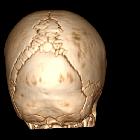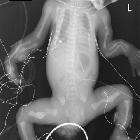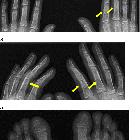Sutural bone















Wormian bones (also knows as intrasutural bones) is the name given to the additional small bones sometimes found between the cranial sutures of the bones of the skull vault, most commonly in relation to the lambdoid suture. Some reserve the term Wormian bones to just the intrasutural bones proximate to the lambdoid suture.
Some consider them abnormal only if greater than 10 in number.
Epidemiology
The reported incidence is variable, ranging from around 10% (in Caucasian skulls) and 40% (in Indian skulls) to 80% (in Chinese skulls) . In general, males are more frequently affected than females .
Associations
Their associations are various, and include:
- pyknodysostosis
- osteogenesis imperfecta
- rickets
- kinky hair syndrome
- cleidocranial dysostosis
- hypothyroidism
- hypophosphatasia
- otopalatodigital syndrome
- primary acro-osteolysis (Hajdu-Cheney syndrome)
- pachydermoperiostosis
- progeria
- Down syndrome
Wormian bones can also be idiopathic (anatomical variant).
A useful mnemonic is PORKCHOPS.
Locations
- lambdoid suture: most common
- lambda (also known as the pre-interparietal or inca bone)
- pterion: up to 12%; former anterolateral fontanelle (also known as the epipteric bone or pterion ossicle)
- sagittal and coronal sutural bones: uncommon
History and etymology
Wormian bones are named after the Danish physician, theologian and antiquary Ole Worm (Olaus Wormius) (1588-1654) , who first described them.
Siehe auch:
- Osteogenesis imperfecta
- Rachitis
- Kleidokraniale Dysplasie
- akzessorische Suturen des Schädels
- Pyknodysostose
- Menkes-Syndrom
- primäre hypertrophe Osteoarthropathie
- Hypophosphatasie
- Inkabein
- Os bregmaticum
- Ossa interfonticulorum cranii
- Stratton-Parker-Syndrom
- Os epiptericum
- Os asteriacum
- Os paramendosum
- Os supramastoideum
- Os postfrontale
- PORKCHOPS
und weiter:

 Assoziationen und Differentialdiagnosen zu Wormsche Knochen:
Assoziationen und Differentialdiagnosen zu Wormsche Knochen:






